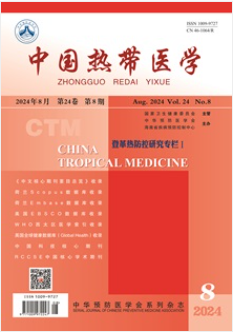Epidemiological analysis of imported malaria reported in Shanghai, 2016-2019
引用次数: 1
Abstract
Objective To understand epidemiological characteristics of malaria cases reported in Shanghai, so as to provide scientific evidence for better prevention and control of malaria. Methods The data of malaria reported in Shanghai during 2016-2019 were collected from the Information Management System for Infection Disease Report and Information Management System for Parasitic Disease Control and Prevention, and the clinical manifestation, diagnosis and treatment were collected and statistically analyzed by SPSS22.0. Results Totally 183 malaria cases were reported in Shanghai during 2016–2019, all of them were laboratory confirmed cases, including 139 P.falciparum cases (76.0%), 23 P.ovale cases (12.6%), 11 P. vivax cases (6.0%), and 10 P. malariae cases (5.5%). All the cases were imported from Africa ( n =178, 97.3%) and southeast Asian ( n =5, 2.73%). Most of the cases fell into the age range of 30-<40 years ( n =59, 32.2%) with a male-to-female ratio of 10.4:1. There were significant differences ( P <0.01) in the rate of misdiagnosis and the rate of over 3 days diagnosis between severe malaria (51.6%, 16/31; 38.7%, 12/31) and non-severe malaria (27.0%, 41/152; 13.8%, 21/152). One severe malaria case was finally dead. Conclusions Imported cases were still existed in Shanghai after malaria elimination. Misdiagnosis and delayed diagnosis were the main factors for the occurrence of severe malaria. It is suggested to carry out health education, active screening and skill training of diagnosis and treatment to achieve "early detection, early diagnosis and early treatment", so as to avoid the occurrence of malaria deaths. 摘要:目的 了解上海市疟疾消除后的流行病学特征, 为制订输人性疟疾的防控策略和措施提供依据。 方法 收集 2016—2019 年上海市疟疾疫情信息和疟疾病例个案调査资料, 采用SPSS22.0统计软件对疟疾病例的流行特征与感 染诊治情况进行统计分析。 结果 2016—2019 年上海市共报告疟疾183例, 均为实验室确诊病例, 其中恶性疟139 例 (占 76.0%), 卵形疟 23 例 (占 12.6%), 间日疟11例 (占6.0%), 三日疟 10 例 (占 5.5%)。所有病例均为境外输人, 分别来 自非洲 (178 例, 占 97.3%)和东南亚(5例, 占 2.7%)。病例的男女性别比为 10.4:1, 年龄 30~<40 岁 (59 例, 占 32.2%)。重 症疟疾的初诊误诊比例 51.6% (16/31) 和超过 3d 确诊比例 38.7% (12/31) 与非重症疟疾的 27.0% (41/152)、13.8% (21/152) 的差异均有统计学意义 ( P <0.01), 1 例重症病例导致死亡。 结论 疟疾消除以后上海市仍然面临境外输人的风 险, 首诊误诊和确诊时间延迟是重症疟疾发生的主要影响因素。建议有针对性地开展风险人群健康宣教、主动筛査以 及诊疗技能培训, 做到“早发现、早诊断、早治疗”, 避免疟疾死亡病例的发生。2016-2019年上海市输入性疟疾流行病学分析
目的了解上海市疟疾病例的流行病学特征,为更好地预防和控制疟疾提供科学依据。方法通过传染病报告信息管理系统和寄生虫病预防控制信息管理系统收集2016-2019年上海市疟疾报告数据,采用SPSS22.0软件对其临床表现、诊断和治疗情况进行统计分析。结果2016-2019年上海市共报告疟疾病例183例,均为实验室确诊病例,其中恶性疟139例(76.0%)、卵形疟23例(12.6%)、间日疟11例(6.0%)、疟疾10例(5.5%)。所有病例均来自非洲(n =178, 97.3%)和东南亚(n =5, 2.73%)。年龄以30 ~ <40岁者居多(n =59, 32.2%),男女比例为10.4:1。重症疟疾患者误诊率和3 d以上诊断率(51.6%,16/31;38.7%(12/31)和非严重疟疾(27.0%,41/152;13.8%, 21/152)。一个严重的疟疾病例最终死亡。结论消除疟疾后上海市仍存在输入性病例。误诊和延误诊断是重症疟疾发生的主要因素。建议开展健康教育、积极筛查和诊疗技能培训,做到“早发现、早诊断、早治疗”,避免疟疾死亡的发生。摘要:目的 了解上海市疟疾消除后的流行病学特征, 为制订输人性疟疾的防控策略和措施提供依据。 方法收集2016 - 2019年上海市疟疾疫情信息和疟疾病例个案调査资料,采用SPSS22.0统计软件对疟疾病例的流行特征与感染诊治情况进行统计分析。结果2016 - 2019年上海市共报告疟疾183例,均为实验室确诊病例,其中恶性疟139例(占76.0%),卵形疟23例(占12.6%),间日疟11例(占6.0%),三日疟10例(占5.5%)。所有病例均为境外输人,分别来自非洲(178例,占97.3%)和东南亚(5例,占2.7%)。4 . 1, 30~<40(59, 32.2%)。重症疟疾的初诊误诊比例占51.6%(16/31)和超过3 d确诊比例38.7%(12/31)与非重症疟疾的27.0%(41/152),13.8%(21/152)的差异均有统计学意义(P < 0.01), 1例重症病例导致死亡。结论 疟疾消除以后上海市仍然面临境外输人的风 险, 首诊误诊和确诊时间延迟是重症疟疾发生的主要影响因素。建议有针对性地开展风险人群健康宣教、主动筛査以 及诊疗技能培训, 做到“早发现、早诊断、早治疗”, 避免疟疾死亡病例的发生。
本文章由计算机程序翻译,如有差异,请以英文原文为准。
求助全文
约1分钟内获得全文
求助全文
来源期刊
CiteScore
0.60
自引率
0.00%
发文量
13927
期刊介绍:
China Tropical Medicine, was approved by the Ministry of Science and Technology in 2001, is the only tropical medicine periodical under the charge of the National Health Commission of China. It’s organized by Hainan Provincial Center for Disease Prevention and Control, and Chinese Preventive Medicine Association.
The journal is indexed by the following database: Scopus database, Embase database, EBSCO Database, The Western Pacific Region index medicus (WPRIM), American Chemical Abstracts (CA), International Centre for Agricultural and Biological Sciences Research Database (CABI), Global Health Database, Database of the Ulrich's Periodicals Directory, China Science and Technology Core Journals, China Core Journals (Selection) Database, Database of Chinese Biomedical Literature, Comprehensive Evaluation Database of Chinese Academic Journals, CAJCD Code of Conduct Excellent Journal, Database of Chinese SCI-Tech Periodicals, China Journal Full Text Database.

 求助内容:
求助内容: 应助结果提醒方式:
应助结果提醒方式:


